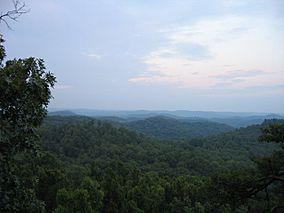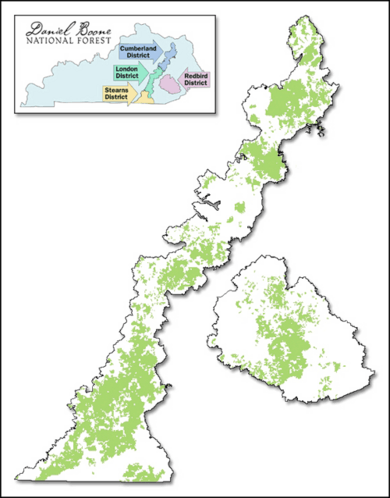Daniel Boone National Forest facts for kids
Quick facts for kids Daniel Boone National Forest |
|
|---|---|

View from Tater Knob in the Daniel Boone National Forest
|
|
| Location | Kentucky, USA |
| Area | 2,100,000 acres (8,500 km2)(proclamation boundary); 706,000 acres (286,000 ha) (Forest Service) |
| Established | February 23, 1937 |
| Named for | Daniel Boone |
| Visitors | 2,507,000 (in 2004) |
| Governing body | U.S. Forest Service |
| Website | Daniel Boone National Forest |
The Daniel Boone National Forest is a huge national forest in Kentucky, USA. It was created in 1937 and was first called the Cumberland National Forest. In 1966, its name changed to honor the famous explorer, Daniel Boone.
This forest covers about 708,000 acres of land owned by the government. It's a rugged place with many rivers and lakes. You can find lots of different plants and animals here. Even though some areas were logged a long time ago, the forest is now protected. It's a very popular spot for visitors, with over a million people coming each year to enjoy nature and outdoor activities.
Contents
Exploring the Daniel Boone National Forest
The Daniel Boone National Forest is a large area of land in Kentucky. It includes both public and private land. The forest is divided into two main parts. These are a long strip of land along the western edge of the Cumberland Plateau and an area called the Redbird Purchase.
The land is mostly hilly and mountainous. The hills can be as high as 2,000 feet in the southern parts. The forest is managed by four ranger districts. These districts help protect the land and guide visitors.
The Daniel Boone National Forest spreads across 21 counties in Kentucky. These counties include:
Water Features in the Forest

Many important rivers flow through the forest. These include the Licking River, Kentucky River, and Cumberland River. All these rivers eventually flow into the Ohio River.
There are also four large lakes in the forest. These lakes are Cave Run Lake, Buckhorn Lake, Lake Cumberland, and Laurel River Lake. They are managed by the United States Army Corps of Engineers. Together, these lakes cover about 63,850 acres of water.
Thousands of smaller streams also crisscross the forest. Many of these streams only flow after heavy rain. The forest also has many riparian zones (areas along rivers) and wetlands.
The water quality in the forest is generally good. However, some mining activities can affect it. The area gets about 46 inches of rain each year. Heavy rains can sometimes cause local flooding. But during dry times, many small streams can dry up completely.
Air Quality in the Forest
The air in the Daniel Boone National Forest is very clean. This is because there aren't many people or big industries nearby. Most of the air pollution comes from forest fires. About 128 forest fires happen each year. Most of these fires are caused by people. Some pollution also comes from controlled burning and dust from unpaved roads.
History of the Daniel Boone National Forest
The land that is now the Daniel Boone National Forest has a long history. Both the French and British empires claimed this land in the 16th century. Early European explorers like René-Robert Cavelier, Sieur de La Salle, and Thomas Walker visited the area. Walker was the first European to find the Cumberland Gap.
Daniel Boone's Expeditions
Around 1760, Daniel Boone began exploring this wilderness. He helped prepare the land for settlers who wanted to move west. Boone made several trips into Kentucky. In 1769, he explored through the Cumberland Gap. He stayed in Kentucky until 1771.
In 1775, a group called the Transylvania Colony bought a large area of land from the Cherokee Nation. This land included much of modern-day Kentucky. Daniel Boone helped mark and clear trails in this new land. He also helped found Fort Boone, which became part of the early Transylvania Colony. Later, this area became part of Virginia and then the Commonwealth of Kentucky.
Industrial Use of the Forest
Before the 1900s, the Daniel Boone forest was heavily logged. Trees were cut down and sent to sawmills in cities like Louisville and Nashville. The logging industry was biggest around 1907. The forest also provided wood for making charcoal for iron factories. As railroads grew, wood was used for crossties and building bridges.
How the Forest Became Protected
In the early 1900s, the U.S. Congress started looking into buying land in the southern Appalachian Mountains. They wanted to create national forests. In 1911, the Weeks Act provided more money for this.
In 1914, a report suggested that this area in Kentucky was perfect for a national forest. It said the land was rugged and important for the Kentucky River. It also noted that land prices were good for buying.
Land purchases began in 1933. Large amounts of land were bought from coal and lumber companies. By 1937, the area was officially named the Cumberland National Forest. It covered over 400,000 acres across 16 Kentucky counties.
People suggested naming the forest after Daniel Boone or Henry Clay. But it wasn't until 1966 that the name officially changed. President Lyndon B. Johnson renamed it the Daniel Boone National Forest. This happened after the Kentucky Senate asked the U.S. Department of Agriculture to make the change.
Wildlife and Nature in the Forest
The Daniel Boone National Forest is home to many kinds of trees. There are about 40 types of commercial trees and many other non-commercial trees and shrubs. You can find mixed hardwood trees like oaks and hickories, as well as white and yellow pine trees. Because much of the forest was logged in the past, some areas have younger, higher-quality trees now.
Animals Living in the Forest
The forest is full of diverse animal life. It has 54 types of mammals, 194 types of birds, 44 types of reptiles, 41 types of amphibians, and 150 types of fish.
You might see animals like black bears, coyotes, bobcats, and white-tailed deer. Other common animals include wild turkeys, gray squirrels, raccoons, and opossums. Rare species like the red-cockaded woodpecker and different types of bats also live here.
The lakes and rivers are home to many fish. These include rainbow trout, large and smallmouth bass, bluegill, and crappie.
Fun Activities in the Forest

The Daniel Boone National Forest offers many fun things to do. There are about 100 developed recreation areas. It also has over 600 miles of trails. More than a million people visit the forest each year to enjoy these activities.
You can go hiking, mountain biking, rock climbing, boating, and horse riding. The forest has enough space for many visitors at once.
Parks and Trails to Explore
Inside the forest, you'll find three state parks. These are Buckhorn Lake, Cumberland Falls, and Natural Bridge. There is also a special area called the Big South Fork National River and Recreation Area.
The Sheltowee Trace Trail is a very long trail in the forest. It stretches almost 290 miles across Kentucky. There are also two special wilderness areas called Beaver Creek and Clifty Wilderness. These areas are protected to keep them wild. The Red River Gorge is also a famous natural landmark within the forest.
Hunting in the Forest
Hunting is another popular activity in the forest. There's a special area called the Pioneer Weapons Wildlife Management Area. Here, hunters can only use older types of weapons. These include muzzleloaders, bows and arrows, or crossbows. This area is a partnership between the Kentucky Department of Fish and Wildlife Resources and the U.S. Forest Service.



